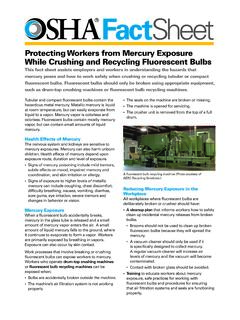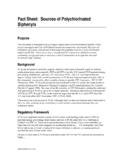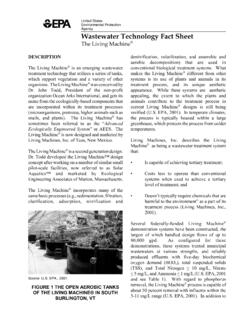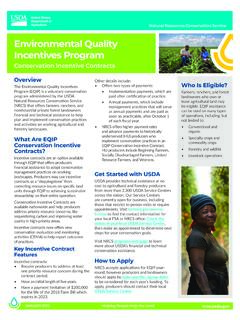Transcription of Stormwater Best Management Practices: Concrete Washout
1 Construction workers should handle wet Concrete and Washout water with care because it may cause skin irritation and eye damage. If the washwater is dumped on the ground (Fig. 1), it can run off the construction site to adjoining roads and enter roadside storm drains, which discharge to surface waters such as rivers, lakes, or estuaries. The red arrow in Figure 2 points to a ready mixed truck chute that s being washed out into a roll-off bin, which isn t watertight. Leaking washwater, shown in the foreground, will likely follow similar paths to nearby surface waters. Rainfall may cause Concrete Washout containers that are uncovered to overflow and also transport the washwater to surface waters.
2 Rainwater polluted with Concrete washwater can percolate down through the soil and alter the soil chemistry, inhibit plant growth, and contaminate the groundwater. Its high pH can increase the toxicity of other substances in the surface waters and soils. Figures 1 and 2 illustrate the need for better Washout Management Management Practice ObjectivesThe best Management practice objectives for Concrete Washout are to (a) collect and retain all the Concrete Washout water and solids in leak proof containers, so that this caustic material does not reach the soil surface and then migrate to surface waters or into the ground water, and (b) recycle 100 percent of the collected Concrete Washout water and solids.
3 Another Description of Concrete Washout at Construction SitesConcrete and its ingredientsConcrete is a mixture of cement, water, and aggregate material. Portland cement is made by heating a mixture of limestone and clay containing oxides of calcium, aluminum, silicon and other metals in a kiln and then pulverizing the resulting clinker. The fine aggregate particles are usually sand. Coarse aggregate is generally gravel or crushed stone. When cement is mixed with water, a chemical reaction called hydration occurs, which produces glue that binds the aggregates together to make washoutAfter Concrete is poured at a construction site, the chutes of ready mixed Concrete trucks and hoppers of Concrete pump trucks must be washed out to remove the remaining Concrete before it hardens.
4 Equipment such as wheelbarrows and hand tools also need to be washed down. At the end of each work day, the drums of Concrete trucks must be washed out. This is customarily done at the ready mixed batch plants, which are usually off-site facilities, however large or rural construction projects may have on-site batch plants. Cementitious (having the properties of cement) washwater and solids also come from using such construction materials as mortar, plaster, stucco, and and Human Health ImpactsConcrete Washout water (or washwater) is a slurry containing toxic metals. It s also caustic and corrosive, having a pH near 12.
5 In comparison, Drano liquid drain cleaner has a pH of Caustic washwater can harm fish gills and eyes and interfere with reproduction. The safe pH ranges for aquatic life habitats are 9 for freshwater and for saltwater. Figure 1. Chute washwater being dumped on the groundMinimum MeasureConstruction Site Stormwater Runoff ControlSubcategoryGood Housekeeping/Materials ManagementFigure 2. Chute washwater leaking from a roll-off bin being used as a Washout containerOffice of Water, 833-F-11-006 February 2012 Stormwater Best Management PracticeConcrete Washout Stormwater Best Management Practice: Concrete Washout2objective is to support the diversion of recyclable materials from landfills.
6 Table 1 shows how Concrete Washout materials can be recycled and 1 recycling Concrete Washout materialsUses of Recycled MaterialsConcrete Washout MaterialsWashwaterCement finesaFine aggregateCoarse aggregateHardened concreteUnused wet concreteReused to Washout additional mixer truck chutes or drums xReused as a ready mixed Concrete ingredient xxbxxReused as an ingredient of precast Concrete products, , highway barriers, retaining wall blocks, riprapxxxxxReused as crushed Concrete products, , road base or fill xxxxReused to pave the yards of ready mixed Concrete plantsxReturned back to a surface water, , river, lake, or estuaryxca.
7 Fine particles of cementitious material ( , Portland cement, slag cement, fly ash, silica fume)b. Recyclable, if allowed by the Concrete quality specificationsc. Treated to reduce the pH and remove metals, so it can be delivered to a municipal wastewater treatment plant, where it is treated further and then returned to a natural surface waterWashwater recycling , treatment, disposalWashwater from Concrete truck chutes, hand mixers, or other equipment can be passed through a system of weirs or filters to remove solids and then be reused to wash down more chutes and equipment at the construction site or as an ingredient for making additional Concrete .
8 A three chamber Washout filter is shown in Figure 3. The first stage collects the coarse aggregate. The middle stage filters out the small grit and sand. The third stage has an array of tablets that filter out fines and reduces the pH. The filtered washwater is then discharged through a filter sock. An alternative is to pump the Washout water out of the Washout container (Fig 4) and treat the washwater off site to remove metals and reduce its pH, so it can be delivered to a publicly owned treatment works (POTW), also known as a municipal wastewater treatment plant, which provides additional treatment allowing the washwater to be discharged to a surface water.
9 The POTW should be contacted to inquire about any pretreatment requirements, , the National Pretreatment Standards for Prohibited Dischargers (40 CFR ) before discharging the washwater to the POTW. The washwater can also be retained in the Washout container and allowed to evaporate, leaving only the hardened cementitious solids to be recyclingThe course aggregate materials that are washed off Concrete truck chutes into a Washout container can be either separated by a screen and placed in aggregate bins to be reused at the construction site or returned to the ready mixed plant and washed into a reclaimer (Fig. 5).
10 When washed out into a reclaimer, the fine and course aggregates are separated out and placed in different piles or bins to be reused in making fresh Concrete . Reclaimers with settling tanks separate cement fines from the washwater, and these fines can also be used in new Concrete unless prohibited by the user s Concrete quality Concrete recyclingWhen the washwater in a construction site Concrete Washout container has been removed or allowed to evaporate, the hardened Concrete that remains can be crushed (Fig. 6) and reused as a construction material. It makes an excellent aggregate for road base and can be used as fill at the construction site or delivered to a recycler.


















